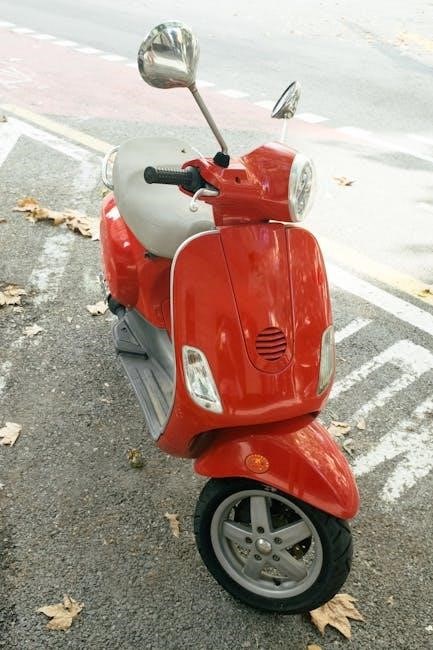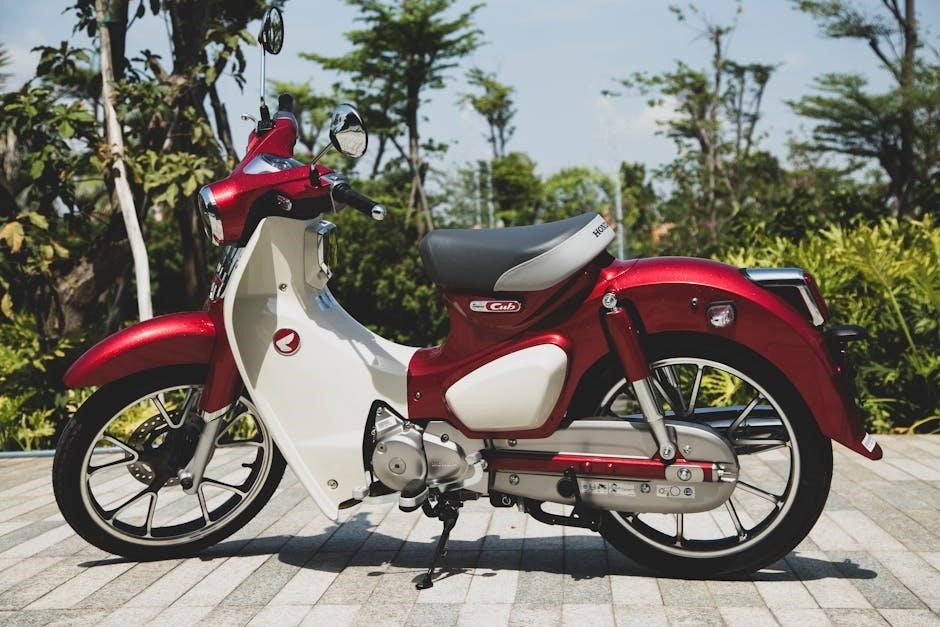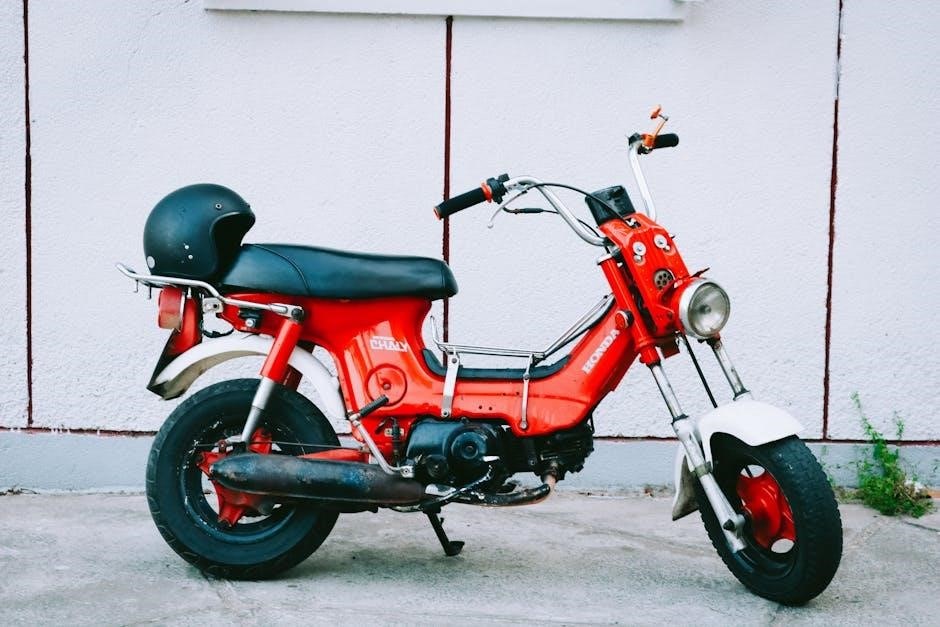Mobility scooter manuals are essential guides providing detailed instructions for safe operation‚ maintenance‚ and troubleshooting. They help users understand features‚ ensure proper usage‚ and address common issues efficiently.
1.1 What Are Mobility Scooter Manuals?
Mobility scooter manuals are comprehensive guides that provide detailed instructions for the safe and effective use of a scooter. They include information on assembly‚ operation‚ maintenance‚ and troubleshooting. These manuals are typically available in PDF format and can be downloaded from manufacturer websites or online databases. They serve as essential resources for users to understand their scooter’s features‚ ensure proper usage‚ and address common issues. Key sections often include safety guidelines‚ control functions‚ and repair tips.
1.2 Importance of Reading Mobility Scooter Manuals
Reading mobility scooter manuals is crucial for ensuring safety‚ understanding proper operation‚ and maximizing the benefits of your scooter. These guides provide essential information on safety precautions‚ maintenance routines‚ and troubleshooting common issues. By following the manual‚ users can avoid accidents‚ extend the scooter’s lifespan‚ and comply with legal requirements. It empowers users to operate their scooters confidently and effectively‚ ensuring independence and mobility.
1.3 Brief History of Mobility Scooter Manuals
Mobility scooter manuals have evolved alongside advancements in scooter technology. Initially simple guides‚ they now include detailed safety protocols‚ troubleshooting tips‚ and legal advice. The rise of digital formats has made manuals more accessible‚ with PDF downloads available online. This shift ensures users can easily access critical information‚ reflecting the growing importance of mobility scooters in aiding individuals with limited mobility and promoting independent living.

How to Download Mobility Scooter Manuals
To download mobility scooter manuals‚ visit manufacturer websites or use search engines to locate specific models. Most manuals are available as downloadable PDFs for easy access and reference.
2.1 Finding the Correct Manual for Your Scooter
To find the correct manual for your scooter‚ identify your model number or product name‚ then visit the manufacturer’s official website or search databases like Manuals.co.uk. Use specific keywords in search engines‚ such as the brand and model‚ to locate the manual quickly. Many websites offer direct PDF downloads‚ ensuring easy access to the guide you need. Always verify the source to ensure accuracy and safety.
2.2 Steps to Download Manuals from Manufacturer Websites
Visit the manufacturer’s official website and navigate to the “Support” or “Resources” section. Locate the “Manuals” or “Downloads” tab and search for your scooter model using the search bar. Select the appropriate manual‚ choose your language if options are available‚ and click the download button. Ensure the file is in a readable format like PDF. Always verify the source to confirm authenticity and safety.
2.3 Using Search Engines to Locate Manuals
Using search engines like Google can efficiently locate mobility scooter manuals. Enter the brand‚ model‚ and terms like “manual” or “download” to find results quickly. This method is effective for accessing the correct guide without visiting the manufacturer’s site directly. Always verify the source to ensure authenticity and safety‚ avoiding potential scams or incorrect information. This approach saves time and ensures you have the right manual for your scooter.
2.4 Tools and Software for Opening and Viewing PDF Manuals
To view or print PDF mobility scooter manuals‚ use software like Adobe Acrobat Reader or Foxit Reader. These tools allow zooming‚ searching‚ and annotating documents. Online converters can also transform PDFs into other formats for easier reading. Ensure the software is up-to-date for compatibility. Additionally‚ some browsers support PDF viewing without external software. Always download tools from trusted sources to avoid security risks and ensure reliable access to your manual.

Key Sections of a Mobility Scooter Manual
Mobility scooter manuals typically include safety guidelines‚ assembly instructions‚ operating procedures‚ and maintenance tips. These sections ensure users understand their scooter’s features‚ usage‚ and care requirements.
3.1 Safety Guidelines and Precautions
Safety guidelines in mobility scooter manuals are crucial for ensuring safe operation. They include warnings‚ symbols‚ and precautions to avoid accidents and injuries. Key points often cover weight limits‚ speed restrictions‚ and proper braking techniques. Users are also advised to wear protective gear and avoid risky terrain. Regular inspections of tires‚ brakes‚ and batteries are emphasized to maintain safety and functionality. Adhering to these guidelines helps prevent hazards and ensures a secure riding experience.
3.2 Assembly and Disassembly Instructions
Assembly and disassembly instructions in mobility scooter manuals guide users through step-by-step processes. These sections often include unfolding‚ attaching accessories‚ and securing parts. Tools required and safety precautions are highlighted to ensure proper assembly. Disassembly instructions are provided for storage or transport‚ emphasizing careful handling to avoid damage. Following these guidelines helps maintain the scooter’s integrity and ensures safe‚ efficient reassembly when needed.
3.3 Operating Instructions and Controls
Operating instructions in mobility scooter manuals detail how to safely control and maneuver the scooter. These sections explain throttle controls‚ brake systems‚ and speed settings. They also cover starting procedures‚ steering mechanisms‚ and how to adjust settings for optimal performance. Safety tips‚ such as proper posture and visibility‚ are emphasized to ensure a smooth and secure riding experience for all users.
3.4 Maintenance and Troubleshooting Tips
Mobility scooter manuals provide detailed maintenance schedules and troubleshooting guides. Regular checks include battery charging‚ tire pressure‚ and brake function. Tips for cleaning and storing the scooter are also included. Troubleshooting sections address common issues like error codes or malfunctioning controls‚ offering step-by-step solutions. These guides empower users to identify and resolve problems independently‚ ensuring optimal performance and longevity of their mobility scooter.

Troubleshooting Common Issues
Mobility scooter manuals often address common issues like error codes‚ battery problems‚ and control malfunctions. They provide diagnostic steps and solutions to restore functionality quickly and effectively.
4.1 Identifying Common Problems with Mobility Scooters
Common issues with mobility scooters include battery malfunctions‚ error codes‚ and control system failures. Users may also face problems with brakes‚ tires‚ or folding mechanisms. Manuals often list these issues alongside diagnostic steps. By referencing the manual‚ users can identify root causes‚ such as faulty wiring or low battery levels. Regular maintenance and adherence to safety guidelines can help prevent or address these problems effectively‚ ensuring optimal scooter performance and user safety.
4.2 Diagnostic Techniques Using the Manual
The manual provides detailed diagnostic techniques to identify and resolve common issues. Users can refer to error codes‚ troubleshooting guides‚ and step-by-step instructions. By following the manual‚ users can perform basic diagnostics‚ such as checking battery levels or faulty wiring. Manuals also guide users on how to reset systems or replace damaged components. Regularly consulting the manual ensures timely resolution of problems‚ maintaining scooter functionality and user safety effectively.
4.3 Repair and Replacement Guidance
Mobility scooter manuals provide comprehensive repair and replacement guidance‚ ensuring users can address issues effectively. Detailed instructions‚ diagrams‚ and tool lists help users perform repairs safely. Manuals often outline steps for disassembling components‚ replacing parts‚ and reassembling the scooter. They also specify genuine spare parts to maintain performance and safety. This section empowers users to handle repairs confidently‚ minimizing downtime and ensuring optimal functionality. Always follow safety guidelines during repairs.

Safety Guidelines for Mobility Scooter Users

Mobility scooter manuals emphasize safety guidelines‚ such as good eyesight‚ avoiding alcohol‚ and following traffic rules. Users must ensure proper visibility and operate responsibly to minimize risks.
5.1 Understanding Safety Symbols and Warnings
Mobility scooter manuals include safety symbols and warnings to alert users of potential hazards. These symbols‚ often accompanied by brief explanations‚ are crucial for ensuring safe operation. Common symbols may indicate dangers like sharp edges or hot surfaces‚ while warnings provide specific instructions to avoid accidents. Understanding these visual cues is essential for maintaining user safety and preventing damage to the scooter. Regularly reviewing these symbols ensures compliance with safety guidelines and enhances overall mobility scooter experience.
5.2 Best Practices for Safe Operation
Best practices for safe mobility scooter operation include following manufacturer guidelines‚ wearing protective gear like helmets‚ and ensuring clear visibility. Always check surroundings‚ avoid obstacles‚ and maintain a safe speed. Regular maintenance‚ such as battery checks and tire inspections‚ is crucial. Adhere to traffic rules and pedestrian pathways. Proper training and familiarity with controls enhance safety. Prioritize awareness of environmental hazards and weather conditions to ensure a secure and enjoyable experience for all users.
5.3 Legal Requirements for Scooter Users
Mobility scooters are classified as invalid carriages‚ exempting them from traditional drink-driving laws. They are not road legal in some cases‚ requiring adherence to pedestrian pathways. Insurance is recommended for liability coverage. Users must comply with local regulations‚ such as speed limits and access restrictions. Understanding these legal requirements ensures lawful usage‚ preventing fines and enhancing public access rights for scooter users.

Choosing the Right Mobility Scooter
Mobility scooter manuals provide essential details about each model‚ helping users compare features‚ understand capabilities‚ and make informed decisions based on specific needs and preferences.
6.1 Factors to Consider When Selecting a Scooter
When choosing a mobility scooter‚ consider portability‚ comfort‚ battery life‚ and terrain compatibility. Ensure the scooter meets legal requirements for its intended use‚ such as road legality or indoor suitability. Assess weight capacity‚ seat height‚ and storage space. Additional features like speed‚ suspension‚ and accessory compatibility should align with your lifestyle and needs. Consulting manuals or professionals can help narrow down the best options for your specific requirements and preferences.
6.2 Comparing Different Models and Brands
Comparing mobility scooter models and brands involves evaluating features like portability‚ weight capacity‚ and battery life. Research brands such as Zipr‚ EWheels‚ and eQuipMed‚ noting their specific offerings. Consider terrain suitability‚ speed‚ and accessory options. Manuals often highlight unique features‚ helping you match the scooter to your lifestyle. Reviews and professional advice can further guide your decision‚ ensuring the chosen model meets your mobility and comfort needs effectively.
6.3 Consulting Professionals for Recommendations
Occupational therapists and physiotherapists can provide expert advice on selecting the right mobility scooter. They assess your needs and recommend models suited to your lifestyle and abilities. Professionals consider factors like mobility requirements‚ terrain‚ and safety features. Their insights‚ combined with manual reviews‚ ensure a well-informed decision‚ enhancing independence and comfort for users with specific medical conditions or limited mobility‚ as highlighted in various user manuals and resources.

Legal and Regulatory Considerations
Understanding mobility scooter laws‚ insurance requirements‚ and liability is crucial. Users must comply with local regulations to ensure legal operation and access to public spaces safely.
7.1 Mobility Scooter Laws and Regulations
Mobility scooter laws vary by region‚ often classifying scooters as invalid carriages with specific rules. Users must adhere to speed limits‚ road usage‚ and safety standards. In the EU‚ urban residents make up over 70% of the population‚ influencing accessibility laws. Legal fog surrounds scooter classifications‚ with distinctions between class 2 and class 3 models affecting road legality. Compliance ensures safe public access and avoids legal issues.
7.2 Insurance and Liability Issues
Understanding insurance and liability is crucial for mobility scooter users. While some regions may not require insurance‚ having coverage can protect against accidents or damage. Legal cases‚ such as those highlighted by solicitor Salome Verrell‚ reveal complexities in liability. Users should consult local laws and consider insurance options to ensure financial protection and peace of mind while operating their scooters.
7.4 Public Access and Mobility Rights
Mobility scooters play a vital role in enabling public access for individuals with limited mobility. Many Municipal Councils provide mobility maps to help users identify accessible locations. Legally‚ mobility scooters are classified as invalid carriages‚ exempting them from certain regulations. This designation ensures users can navigate public spaces independently. Advocacy efforts continue to expand accessibility‚ promoting inclusivity in urban environments for all scooter users.

Accessories and Customization
Enhance your mobility scooter with essential accessories like baskets‚ canopies‚ and storage solutions. Customize your scooter with ergonomic adjustments‚ style options‚ and maintenance kits for optimal comfort and functionality.
8.1 Essential Accessories for Enhanced Comfort
Essential accessories like ergonomic seats‚ padded armrests‚ and adjustable headrests ensure maximum comfort during extended use. Additional features such as storage baskets‚ cup holders‚ and weather canopies enhance convenience. Customizable cushions and backrests provide tailored support‚ reducing fatigue. These accessories not only improve riding comfort but also adapt to individual needs‚ making your mobility scooter a more practical and enjoyable solution for daily activities.
8.2 Customizing Your Scooter for Specific Needs
Customizing your mobility scooter enhances comfort and functionality. Add storage solutions like baskets or bags for convenience. Install lighting or reflective accessories for visibility. Ergonomic adjustments‚ such as seat height and armrest positioning‚ can improve posture. Additional features like canopy attachments or specialized seating cater to individual preferences. These customizations ensure your scooter meets your unique lifestyle and mobility requirements‚ offering greater independence and ease of use.
8.3 Maintenance Kits and Spare Parts
Maintenance kits and spare parts are crucial for keeping your mobility scooter in optimal condition. These kits typically include essential tools‚ lubricants‚ and replacement components like tires‚ batteries‚ and brakes. Regularly checking and replacing worn parts ensures smooth operation and extends the scooter’s lifespan. Always refer to your manual for specific maintenance schedules and recommendations to maintain performance‚ safety‚ and reliability over time.

Future Trends in Mobility Scooters
Future trends include advanced technologies like AI‚ eco-friendly designs‚ and integration with smart devices‚ enhancing accessibility‚ sustainability‚ and user experience for mobility scooter users.
9.1 Technological Advancements in Scooter Design
Technological advancements in mobility scooter design are revolutionizing the industry‚ with innovations like AI-powered navigation‚ smart sensors‚ and lightweight materials enhancing performance and user experience. Integrated IoT connectivity enables real-time monitoring and customization‚ while eco-friendly battery technologies improve sustainability. These advancements aim to provide users with safer‚ more efficient‚ and adaptable mobility solutions‚ addressing diverse needs and preferences in modern transportation.
9.2 Sustainability and Eco-Friendly Models
The development of eco-friendly mobility scooters focuses on reducing environmental impact through sustainable materials and energy-efficient designs. Many models now feature recyclable components and lithium-ion batteries‚ which offer longer lifespans and lower carbon footprints. Manufacturers are also prioritizing lightweight frames and energy-saving technologies to minimize resource consumption. These innovations not only benefit the environment but also provide users with cost-effective and durable mobility solutions for the future.
9.3 Integration with Smart Technology
Modern mobility scooters are increasingly integrating smart technology‚ such as GPS navigation‚ Bluetooth connectivity‚ and mobile app controls. These features enhance user experience by providing real-time diagnostics‚ customizable settings‚ and connectivity to healthcare devices. Smart technology also improves safety with features like collision detection and emergency alerts. Manuals now include guides for syncing devices and troubleshooting tech-related issues‚ ensuring users can fully utilize these advanced capabilities for improved mobility and independence.
Mobility scooter manuals are vital resources for safe and effective usage. They provide essential guidance‚ troubleshooting tips‚ and maintenance advice‚ empowering users to maximize their scooter’s potential and longevity.
10.1 Summary of Key Points
Mobility scooter manuals are crucial for understanding proper usage‚ safety‚ and maintenance. They provide detailed guides for operation‚ troubleshooting‚ and customization‚ ensuring users maximize their scooter’s functionality. Regularly reviewing these manuals helps users stay informed‚ avoid common issues‚ and maintain their scooter’s performance. Accessing manuals online simplifies the process‚ with many manufacturers offering downloadable PDF versions tailored to specific models and needs.
10.2 Final Tips for Scooter Users
Always read and follow the manual for your specific scooter model. Prioritize safety by adhering to guidelines and precautions. Regularly maintain your scooter to ensure optimal performance. Familiarize yourself with local laws and regulations. Keep the manual handy for troubleshooting common issues. Customize your scooter to meet your needs but consult professionals for complex modifications. Stay informed about updates or recalls for your model to ensure continued safe and efficient use.
